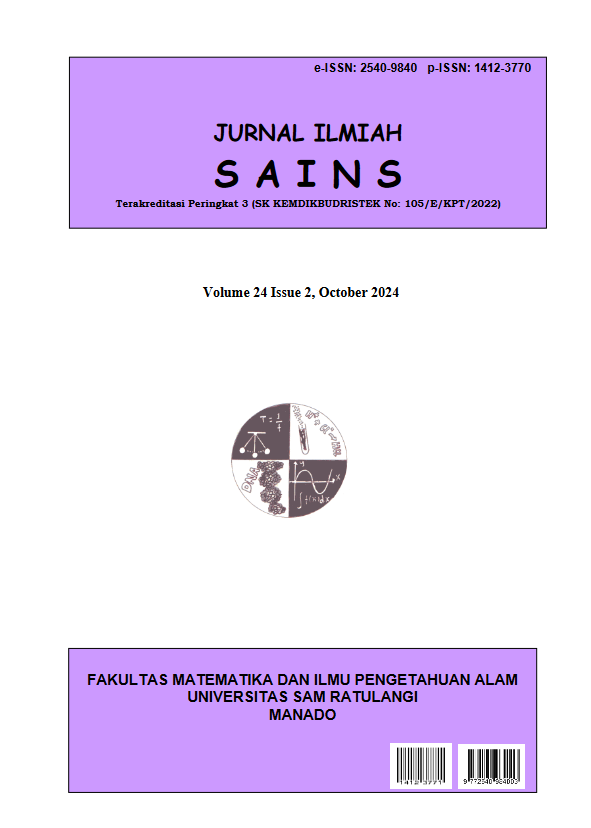Detection of Aquifer Infiltration Zones Using Resistivity and Induced Polarization Methods
DOI:
https://doi.org/10.35799/jis.v24i2.58413Keywords:
Aquifer, resistivity, infiltration zonesAbstract
Infiltration zones that are water providers for aquifers are often neglected, resulting in the sustainable use of groundwater resources will be disrupted. The research is intended to determine rainwater catchment areas as water suppliers for aquifers on the coast of East Tondano Beach. The location of the research is in the coastal area of East Tondano, Minahasa Regency. Exploration of subsurface rock layer detection using the resistivity geoelectric method and induced polarisation, dipole-dipole configuration, 10 m space. Data acquisition using multielectrode resistivity and IP meter MAE type X612-EM. The measurement line of the two methods is the same, the data was measured on 2 lines, with line 1 being 240 m long and line 2 being 360 m long. A rainwater infiltration zone with a resistivity of 48<ρ<192 Ωm was identified, on track 1 there was a infiltration zone at meters 105-135, a layer with low resistivity was identified at meters 70-150 with a resistivity of 3-48 Ωm and a depth of ≥ 15 m.. Based on the results of the IP meter, no suspected groundwater aquifer was found, so rainwater is estimated to flow directly into the sea. On line 2, the infiltration zone was detected at meters 80-105 and meters 275-315. The layer with a low resistivity value at 100-275 meters with a resistivity of 3-48 Ωm, has a depth of ≥ 20 m. The results of the IP measurement, layer with low chargeability ≤ 0.8 ms are found on the 180-200th meter. Suspected groundwater aquifer at 180-200 meters with a depth of 45-65 m.
Keywords: Aquifer; resistivity; infiltration zones
References
Aly, S.T., Suharjo, Diniyati, A., & Arozaq, M. (2017). Model Konservasi Airtanah Daerah Lereng Gunung Merapi Berbasis Budaya Lokal di Kabupaten Klaten Jawa Tengah. Prosiding Seminar Nasional Geografi UMS 2017, 862–869.
Antareza, M.A., Wafi, A., Lasmana, Y., & Mariyanto, M. (2021). Geoelectrical survey and cone penetration test data for groundwater potential determination around Gatot Subroto Street, Banjarmasin. Journal of Physics: Conference Series, 1825(1). https://doi.org/10.1088/1742-6596/1825/1/012015.
As’ari, A., Tongkukut, S. H. J., Pogaga, B. A. ., Akasi, I. A., Sagai, F. S., & Loupatty, T. B. (2019). Investigasi Akuifer Air Tanah di Banua Buha Asri 1 Kelurahan Buha Manado Dengan Menggunakan Metode Geolistrik Resistivitas. Jurnal Ilmiah Sains, 20(1), 1-5. https://doi.org/10.35799/jis.20.1.2020.25143.
Ashraf, M.A.M., Yusoh, R., Sazalil, M.A., & Abidin, M.H.Z. (2018). Aquifer Characterization and Groundwater Potential Evaluation in Sedimentary Rock Formation. Journal of Physics: Conference Series, 995(1). https://doi.org/10.1088/1742-6596/995/1/012106.
Baban, E. N., Amin, A. K., & Ahmed, K. M. (2023). Combined Electrical Tomography (ERT/IP) Methods and Geoelectrical Parameters to Evaluate Groundwater in Qularaisi Area NW Sulaimani City - Kurdistan Region-IRAQ. Iraqi National Journal of Earth Science, 23(1), 1–34. https://doi.org/10.33899/earth.2023.135144.1024.
Burbey, T. J., & Seaton, W. J. (2002). Evaluation of two-dimensional resistivity methods in a fractured crystalline-rock terrane. Journal of Applied Geophysics, 51(1), 21–41.
Dayani, D. ., Wilopo, W., & Azwartika, I. (2022). Geoelectric Methods for Groundwater Exploration in the Food Estate Area of Central Sumba Regency, East Nusa Tenggara, Indonesia. ICSBE, 4(19), 19. https://doi.org/: http//doi.org/10.20885/icsbe.vol2.art12.
Effendi, A.C., & Bawono, S. S. (1997). Peta Geologi Lembar Manado, Sulawesi Utara. Geological research and development Centre.
Hendrayana, H., Riyanto, I.A., & Nuha, A. (2020). Tingkat Pemanfaatan Airtanah di Cekungan Airtanah (CAT) Yogyakarta-Sleman. Geodika: Jurnal Kajian Ilmu Dan Pendidikan Geografi, 4(2), 127–137. https://doi.org/10.29408/geodika.v4i2.2643.
Herlina, N., & Prasetyorini, A. (2020). Effect of Climate Change on Planting Season and Productivity of Maize (Zea mays L.) in Malang Regency. Jurnal Ilmu Pertanian Indonesia, 25(1), 118–128. https://doi.org/10.18343/jipi.25.1.118.
Mahdiyah, U., Akbar, A.A., & Romiyanto, R. (2023). Efektivitas Ruang Terbuka Hijau (RTH) sebagai Daerah Resapan Air dan Penyimpanan Karbon di Kota Pontianak. Jurnal Ilmu Lingkungan, 21(3), 553–564. https://doi.org/10.14710/jil.21.3.553-564.
Masria, A., Alshammari, T.O., Ghareeb, M., Seif, A.K., Abd-Elmaboud, M.E., & Ammar, A.I. (2024). 2D and 3D Modeling of Resistivity and Chargeability to Identify the Type of Saturated Groundwater for Complex Sedimentary Facies. Hydrology, 11(8). https://doi.org/10.3390/hydrology11080120.
Mohamaden, M.I.I., Hamouda, A.Z., & Mansour, S. (2016). Application of electrical resistivity method for groundwater exploration at the Moghra area, Western Desert, Egypt. Egyptian Journal of Aquatic Research, 42(3), 261–268. https://doi.org/10.1016/j.ejar.2016.06.002.
Puluiyo, J., As’ari, A., & Tongkukut, S.H.J. (2018). Perbandingan Konfigurasi Wenner Wenner- Schlumberger , Dipol-dipol Dan Pol-dipol Dalam Metode Geolistrik Tahanan Jenis Untuk Mendeteksi Keberadaan Air Tanah. JURNAL MIPA UNSRAT ONLINE, 7(1), 29–33.
Purwoarminta, A., Lubis, R.F., & Maria, R. (2019). Imbuhan Airtanah Buatan untuk Konservasi Cekungan Airtanah Bandung-Soreang. RISET Geologi Dan Pertambangan, 29(1), 65. https://doi.org/10.14203/risetgeotam2019.v29.1004.
Putranto, T.T., Susanto, N., Pangestuti, D.R., & Pranata, M.A.S. (2020). Pemetaan Hidrogeologi untuk Analisis Zona Konservasi Air Tanah di Cekungan Air Tanah (CAT) Sumowono, Provinsi Jawa Tengah. Jurnal Presipitasi, 17(2), 154–168.
Riwayat, A.I., Nazri, M.A.A., & Abidin, M.H.Z. (2018). Application of electrical resistivity method (ERM) in groundwater exploration. Journal of Physics: Conference Series, 995(1), 012094.
Sulaiman, N., Ariffin, N.A., Sulaiman, M.S., Sulaiman, N., & Jamil, R.M. (2022). Groundwater exploration using Electrical Resistivity Imaging (ERI) at Kemahang, Tanah Merah, Kelantan. IOP Conference Series: Earth and Environmental Science, 1102(1). https://doi.org/10.1088/1755-1315/1102/1/012027.
Sunarmi, N., Kumailia, E.N., Nurfaiza, N., Nikmah, A.K., Aisyah, H.N., Sriwahyuni, I., & Lailly, S.N. (2022). Analisis Faktor Unsur Cuaca terhadap Perubahan Iklim Di Kabupaten Pasuruan pada Tahun 2021 dengan Metode Principal Component Analysis. Newton-Maxwell Journal of Physics, 3(2), 56–64. https://doi.org/10.33369/nmj.v3i2.23380.
Telford, W., Geldart, L., & Sheriff, R. (2004). Applied Geophysics Second Edition.
Undang-Undang No. 27. (2007). Pengelolaan Wilayah Pesisir Dan Pulau-Pulau Kecil. Journal of Chemical Information and Modeling, 53(4), 160.
Unsal, B., Yagbasan, O., & Yazicigil, H. (2014). Assessing the impacts of climate change on sustainable management of coastal aquifers. Environmental Earth Sciences, 72(6), 2183–2193. https://doi.org/10.1007/s12665-014-3130-z.
Wibowo, M. (2019). Model Penentuan Kawasan Resapan Air untuk Perencanaan Tata Ruang Berwawasan Lingkungan. Jurnal Hidrosfir, 1(1), 1–7.
Downloads
Published
How to Cite
Issue
Section
License
Copyright (c) 2024 As'ari As'ari, Seni Herlina J Tongkukut, Ernawatil Gani

This work is licensed under a Creative Commons Attribution-NonCommercial 4.0 International License.
LICENCE: CC-BY-NC
This work is licensed under a Creative Commons Attribution-NonCommercial 4.0 International License







